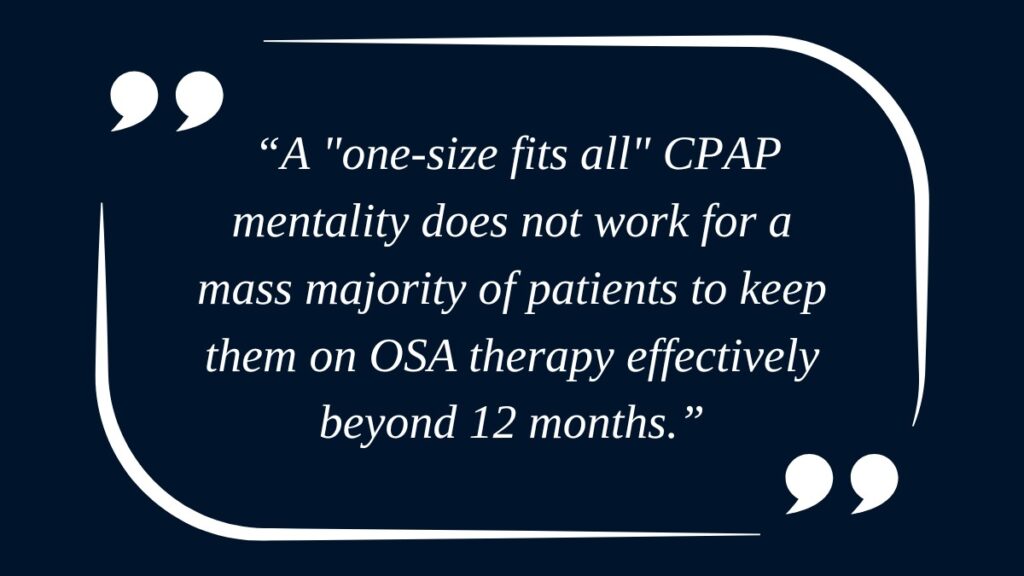During our September 2022 webinar, The Impact of OSA Therapy on Healthcare Costs, we surveyed attendees to gain their insight on what tactics clinicians and patients have for improving long-term obstructive sleep apnea (OSA) treatment success. Long-term success in this case is defined as adherence to therapy for more than 12 months. While reviewing the responses from the webinar, we discovered five common themes from our audience on how to improve long-term OSA adherence in patient populations.
The following post shines light on the research presented by the EnsoData team at SLEEP 2022: “Impact of OSA Therapy on Healthcare Costs: Actuarial Analysis of OSA Prevalence, Therapy Adherence, Co-morbidity, and Costs in a Large Medicare Population Cohort,” and more specifically, pulls themes and details from the follow-up survey to the 2022 webinar.
 Another respondent emphasized the importance of patient-focused care. This individual highlighted research around endotyping: “We are dealing with biological systems and no patient is the same.”
That’s one important key to remember. Each patient is unique. Finding the optimal treatment can have an immensely positive impact on the long-term success they experience. And whether that’s CPAP, an oral appliance, BiPAP, or even physical changes (weight loss), getting the right treatment makes all the difference.
Another respondent emphasized the importance of patient-focused care. This individual highlighted research around endotyping: “We are dealing with biological systems and no patient is the same.”
That’s one important key to remember. Each patient is unique. Finding the optimal treatment can have an immensely positive impact on the long-term success they experience. And whether that’s CPAP, an oral appliance, BiPAP, or even physical changes (weight loss), getting the right treatment makes all the difference.
 Getting ahead of a patient’s fears is important, and while education and coaching is critical up front, it’s equally valuable throughout a patient’s experience. More on that in the next tip.
Looking for more information on sleep coaching? Watch our free webinar: The CCSH Sleep Coach or check out a recent sleep story: The Sleep Coach: A Crucial Role in the Sleep Care Community.
Getting ahead of a patient’s fears is important, and while education and coaching is critical up front, it’s equally valuable throughout a patient’s experience. More on that in the next tip.
Looking for more information on sleep coaching? Watch our free webinar: The CCSH Sleep Coach or check out a recent sleep story: The Sleep Coach: A Crucial Role in the Sleep Care Community.
1. Choose the Right Treatment
There are many elements that can impact the long-term adherence of a patient population, but getting on the right treatment from the get-go is one of the best ways to generate positive patient outcomes. Choosing the wrong treatment plan not only can slow a patient’s progress, but may also deter them entirely. In order to get patients on the best pathway for success, clinicians need to match the proper OSA treatment modality to each individual diagnosed with OSA. Per one respondent, “a “one-size fits all” CPAP mentality does not work for a mass majority of patients to keep them on OSA therapy effectively beyond 12 months.” Another respondent emphasized the importance of patient-focused care. This individual highlighted research around endotyping: “We are dealing with biological systems and no patient is the same.”
That’s one important key to remember. Each patient is unique. Finding the optimal treatment can have an immensely positive impact on the long-term success they experience. And whether that’s CPAP, an oral appliance, BiPAP, or even physical changes (weight loss), getting the right treatment makes all the difference.
Another respondent emphasized the importance of patient-focused care. This individual highlighted research around endotyping: “We are dealing with biological systems and no patient is the same.”
That’s one important key to remember. Each patient is unique. Finding the optimal treatment can have an immensely positive impact on the long-term success they experience. And whether that’s CPAP, an oral appliance, BiPAP, or even physical changes (weight loss), getting the right treatment makes all the difference.
2. Sleep Coaching
One option for patients struggling with their sleep is to seek the help of a sleep coach. Among the responses to our survey, many mentioned that working with patients in a sleep coaching capacity can help improve long-term OSA adherence. Like a personal trainer for your sleep, sleep coaches help patients set and commit to sleep health goals. Sleep coaches do a variety of things to help patients achieve those goals, including providing insight and encouragement to patients along the way. One specific example a respondent shared regarding sleep coaching came on the topic of breathing techniques:“Educate patients on how breathing uses negative inspiratory force and how PAP is positive airway pressure, and it won’t feel comfortable for most patients. In my experience, patients can describe it as claustrophobia asynchronized breathing and discontinue therapy.”
 Getting ahead of a patient’s fears is important, and while education and coaching is critical up front, it’s equally valuable throughout a patient’s experience. More on that in the next tip.
Looking for more information on sleep coaching? Watch our free webinar: The CCSH Sleep Coach or check out a recent sleep story: The Sleep Coach: A Crucial Role in the Sleep Care Community.
Getting ahead of a patient’s fears is important, and while education and coaching is critical up front, it’s equally valuable throughout a patient’s experience. More on that in the next tip.
Looking for more information on sleep coaching? Watch our free webinar: The CCSH Sleep Coach or check out a recent sleep story: The Sleep Coach: A Crucial Role in the Sleep Care Community.
3. Ongoing Follow-up and Support
For many patients, long-term success with OSA therapy is dependent on consistent follow-up and 1:1 care from providers. While thoughtful support during the first few weeks of treatment assists patients with beginning treatment, that is only the first step. To help patients maintain adherence with therapy, it’s important to provide ongoing follow-up and support. What type of support? That will depend on each patient. Frequently reach out to patients to answer questions or address concerns regarding CPAP therapy. Educate the patient on at-home mask cleaning tips. Provide recommendations for partners who may be lighter sleepers struggling to adjust to the whistling noise of leaking masks. The opportunities to support patients are endless, and they can impact patients’ long-term OSA treatment success.Here’s how it was put by one respondent: “I have found the most success with those [patients] who had ongoing interactions with a therapist or technologist to support them and get their questions answered.”The general consensus from the responses received is simply to listen and compassionately address patients’ concerns, and they will benefit. The questions and experiences that may seem basic to clinicians, are likely happening to them for the first time. Proactively following up with patients and supporting them throughout their treatment journey can positively impact outcomes and long-term OSA adherence.
4. Adherence Education is Critical
Education is key to compliance. Specifically, education on why adherence is so important for long-term patient success. This includes helping patients understand how their sleep affects their medical condition and how proper treatment will improve their overall health. One respondent stated this quite plainly: “sitting down with the patient and explaining their sleep study results and what the numbers mean will help them realize the severity of the situation and why they need to be compliant [with therapy]. Most have no idea what is really going on with their health.” Other respondents mentioned consequences can have an impact, as well.“When patients become aware that their driving license could be revoked if they are non-compliant on their treatment, that opens eyes,” said another respondent.Different factors – from losing a license to providing a spouse with a snore-free night – will impact and influence different people. It’s important to provide education throughout the treatment process, but some patients may also need support from friends, family, and others going through a similar experience in addition to assistance from their clinician.





